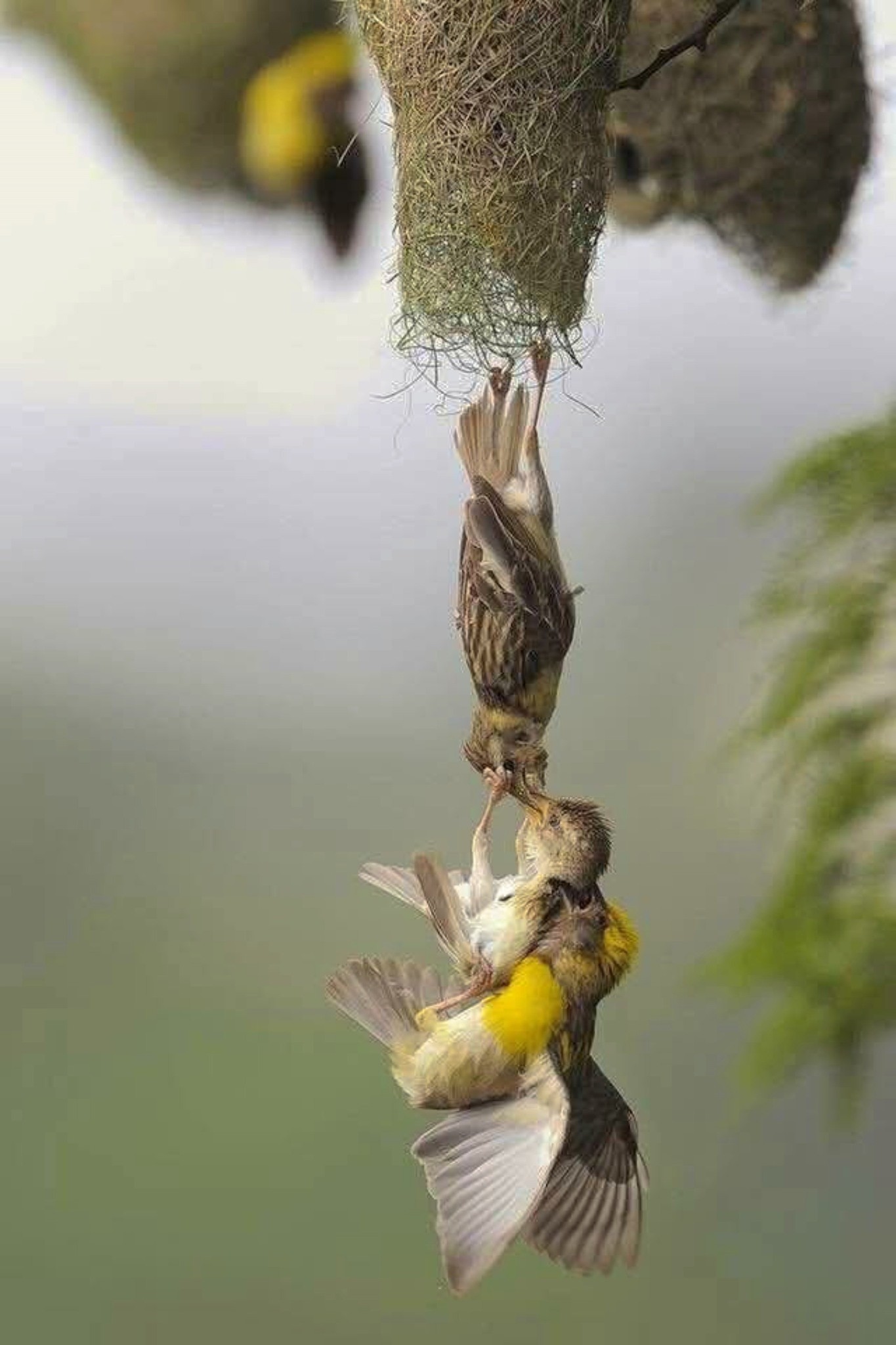The Baya Weaver: Master Architects of the Avian World


Perched amid the dense foliage of tropical landscapes and hanging delicately from swaying palm fronds or acacia branches are some of the most intricate natural constructions found in the animal kingdom — the nests of the Baya Weaver. These gourd-shaped marvels of natural engineering are not the result of human design but are crafted entirely by beaks, claws, and instinct.
The bird responsible for these breathtaking nests is the Baya Weaver (Ploceus philippinus), a small, sociable songbird found across South and Southeast Asia. The Baya Weaver is not just admired for its construction skills; its fascinating behaviors, especially related to breeding, parenting, and colony life, have captivated ornithologists, photographers, and nature lovers alike.
This article offers a comprehensive look into the world of the Baya Weaver: its habitat, physiology, mating rituals, nesting techniques, survival strategies, and the symbolic significance of the species in both ecological and cultural contexts.
Species Overview
Scientific Classification
-
Scientific Name: Ploceus philippinus
-
Family: Ploceidae (Weaverbirds)
-
Order: Passeriformes
-
Common Name: Baya Weaver
-
Conservation Status: Least Concern (IUCN)
The Baya Weaver belongs to the weaver family, a group of birds renowned for their elaborate woven nests. Native to the Indian subcontinent and parts of Southeast Asia, the species is highly adaptable and thrives in a range of environments, from wetlands and grasslands to cultivated fields and urban edges.
Physical Description
Baya Weavers are small, stout birds measuring approximately 15 cm (6 inches) in length. There is a striking difference between the males and females, especially during the breeding season.
Males (Breeding Plumage):
-
Crown and nape: Bright golden yellow
-
Throat and upper breast: Chestnut brown
-
Back and wings: Olive-brown with black streaks
-
Bill: Strong and conical, ideal for weaving
Females and Non-breeding Males:
-
Duller in color
-
Lack the vibrant yellow crown
-
More uniformly brown and streaked for camouflage
Their beak is one of their most specialized tools, designed for not just foraging, but intricately weaving fibers into architectural masterpieces.
Habitat and Distributio
The Baya Weaver has a wide distribution, including:
-
India (especially in the north and central regions)
-
Bangladesh
-
Nepal
-
Sri Lanka
-
Thailand
-
Myanmar
They are usually found near water sources such as marshes, rice fields, rivers, and lakes, where grasses and reeds are plentiful — materials vital for nest construction.
Nesting Behavior: The Ultimate Architects
The hallmark of the Baya Weaver is its unique and complex nest structure. These nests hang from the tips of branches like pendulous baskets and can measure up to 60 cm in length.
Construction Process
-
Material Gathering: Males begin by collecting strips of grass, palm fronds, and other fibrous materials.
-
Initial Loop: They create an anchoring loop around a branch or palm frond.
-
Chamber Formation: They weave the fibers downward, building an enclosed chamber.
-
Tunnel Addition: A tubular entrance is added to deter predators like snakes or crows.
-
Finishing Touches: Interior may be lined with softer grasses or feathers.
A single nest can take up to 18 days to complete, depending on environmental conditions and the male’s experience.
Nest Location
Baya Weavers prefer:
-
Thorny trees like Acacia
-
Trees near water to reduce predator access
-
Colonies with 10–50 nests per tree
Nests are often oriented to face the prevailing wind direction to keep the interior cool and dry during monsoons.
Mating and Courtship
Once a nest is partially complete (the “helmet stage”), the male invites females by fluttering his wings and singing loudly. If a female inspects and approves the nest, mating occurs. If not, the male abandons the nest and starts a new one elsewhere.
Interestingly, Baya Weavers are polygynous — a single male may mate with multiple females, constructing multiple nests in hopes of attracting different partners.
Courtship displays include:
-
Wing-fluttering dances
-
Chirping songs
-
Acrobatic displays hanging upside down from the nest
If a female accepts, she completes the interior nesting area and lays 2–4 eggs.
Parenting and Chick Development
Once eggs are laid, the female assumes full responsibility for incubation and care. The male may continue courting other females or guard the nest colony.
Chick Timeline:
-
Incubation Period: 14–15 days
-
Hatchlings: Born blind and featherless
-
Feeding: Insects, soft seeds, and regurgitated food
-
Fledging: Around 17–20 days after hatching
In the image you provided, we see a fledgling either falling or trying to leave the nest and being rescued mid-air — a testament to the alertness and maternal care that birds like the Baya Weaver provide.
Social Structure and Colony Living
Baya Weavers are highly gregarious birds. During breeding seasons, they form large colonies with synchronized nesting activity. This provides several advantages:
-
Predator Dilution: Higher chance of chick survival
-
Cooperative Alert System: Birds raise alarms when predators approach
-
Mate Selection: Females have more options to select high-quality mates
However, colony living also means intense competition among males. Some nests are built in vain, never attracting a mate, while others are reused or modified.
Vocalization and Communication
Their calls are a mix of:
-
Sharp “chee-chee” notes
-
Soft warbling chirps during courtship
-
Alarm calls when predators approach
Males increase their vocal activity during the breeding season, often singing from the top of their nests to attract mates and ward off rivals.
Predators and Threats
Despite their clever nest designs, Baya Weavers are not free from natural threats:
Predators:
-
Snakes: Tree snakes often attempt to raid nests
-
Crows and Raptors: Can snatch eggs or chicks
-
Monitor Lizards: Occasionally climb to nests
To combat these threats, nests are often built over water or on thorny branches, and colonies help detect danger early.
Human Threats:
-
Habitat Loss: Due to urbanization and agricultural expansion
-
Nest Poaching: For decorative or educational use
-
Pesticides: Reduce insect populations that are crucial for feeding chicks
Despite these, the species is currently listed as Least Concern, thanks to its wide range and adaptability.
Cultural Significance
In parts of India and Southeast Asia, the Baya Weaver is not just admired but symbolized in folklore, poetry, and even economics.
-
Folklore: Often featured in stories for their “diligence” and “artistry”
-
Postage Stamps: Featured in Indian and Sri Lankan postal themes
-
Traditional Lessons: Used in moral education about hard work and perseverance
Their nests are often showcased in natural history museums and used as metaphors in art and literature for structure, home, and love.
The Photograph Revisited: A Real-Time Rescue
The dramatic image you shared — of a fledgling being rescued mid-air — offers a real-time glimpse into the parental instincts and aerial agility of the Baya Weaver. This moment is significant for several reasons:
-
Shows maternal reflexes in saving a vulnerable chick
-
Highlights the precariousness of life at such heights
-
Demonstrates evolutionary design: lightweight yet strong nests, quick reflexes, and communication
It’s not just an image; it’s a story of survival, instinct, and architectural beauty unfolding in one frame.
Conservation Outlook
Although Baya Weavers are not endangered, their long-term survival depends on maintaining:
-
Grasslands and wetland areas
-
Availability of nest-building materials
-
Low human interference during breeding season
Conservationists stress the importance of balancing agriculture with wild buffer zones, using fewer pesticides, and promoting education about bird habitats.
Final Thoughts
The Baya Weaver is more than a small songbird fluttering through fields — it is a living architect, a devoted parent, a social strategist, and an artist of the natural world.
From its astonishing nests to its dynamic courtship rituals, and its careful parenting to its sharp survival instincts, this species represents the wonders of evolution and natural intelligence. It reminds us that even in the smallest of creatures, there exists brilliance, creativity, and care that rivals any achievement of humankind.
Photographs like the one you shared illuminate not only rare moments but also the everyday heroics of creatures who weave, guard, and nurture — quietly shaping the world around them, one strand of grass at a time.











